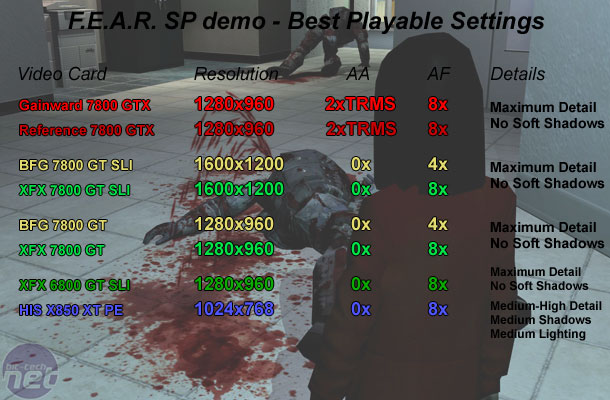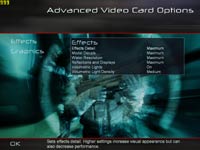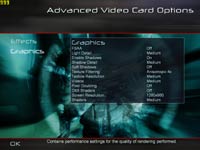F.E.A.R. - single player demo
Publisher: VU GamesWe are using the F.E.A.R. public demo that was released last Friday. It is on course to become the best shooter of 2005. The game makes use of a lot of shadows - including soft shadows, volumetric lighting, parallax mapping and particle effects along with a slow-motion mode that really taxes today's top of the line GPU's. There's a massive use of high resolution textures, the walls are both bump mapped and parallax mapped to give a realistic feel to the brick walls that are a big feature of this title. Also, the world is incredibly destructible - the inclusion of parallax mapping really helps to make the destructible world look incredibly real too.
In general, this is a pretty graphically intense game and the most outstanding part of the graphics engine is undoubtably the player character's shadow that is cast on the wall. There are times when you turn around and shoot your own shadow because the game gets that far under your skin.
F.E.A.R. also has the most advanced A.I. that we have ever seen in a game engine to date - there are times when you'll find yourself with your pants down around your ankles with no where to go. For anyone who hasn't played this demo yet, it's well worth a look - check out our F.E.A.R. preview here.
Anti-Aliasing and Anisotropic Filtering were controlled from inside the game, and thus drivers were left set to "Application Controlled".
Below is a table of the best-playable settings that we found best for each video card configuration. In this title, we experienced a lot of hitching and found that the frame rate could regularly jump in to the mid teens. We feel that the drivers need some work before the game is released in order to remove the hitching we were experiencing at all resolutions on any video card that we threw at this title.
After our Gainward Ultra/3500PCX XP Golden Sample review, we played around with memory sizes and found that the game really requires 2x1GB memory modules in order to experience smooth gaming. The game is very memory quantity and memory bandwidth hungry - 4x512MB modules running 2.0-2-2-10 2T was actually slower than 2x512MB modules running at 2.0-2-2-10 1T. However, when we increased the front side bus to make up for some of the lost bandwidth, we found that some of the hitching went away.
We decided that a minimum frame rate of around 15 frames per second and an average of over 60 frames per second would deliver the best-possible gaming experience in the circumstances. This was not what we would call smooth gaming, but it was about as smooth as possible given the issues we were having in achieving smooth game play with 1GB of memory.

We found that BFGTech's GeForce 7800 GT OC was able to play the game at 1280x960 0xAA 4xAF, while the additional clock speed on the XFX card allowed us to increase the Anisotropic Filtering from 4x to 8x at the same resolution. The minimum frame rates were about the same, give or take a single frame per second, while the XFX managed to increase the average frame rate by a single frame per second, too - that's with the additional Anisotropic Filtering applied to the scene.
Due to the game not having an SLI profile at the moment, we had to enable the Coolbits hack that allows you to force an SLI mode in all games. If you go in to regedit and go to 'HKLM/Software/NVIDIA Corp./Global/NVTweak' and create a new DWord called 'Coolbits' with the decimal value '8', you will be able to force an SLI mode for every game that doesn't have an optimised profile, as we showed in Tuesday's GeForce 7800 GTX review. We found that AFR was the best mode with the GeForce 7800 GT's too, although those of you with a slower CPU may find that Split Frame Rendering delivers the best performance in this title.
The BFGTech GeForce 7800 GT OC SLI combination managed to bump the resolution up from 1280x960 to 1600x1200 - the rest of the in-game details remained the same at 0xAA 4xAF. The same was true with XFX's GeForce 7800 GT SLI - we also bumped from 1280x960 0xAA 8xAF to 1600x1200 0xAA 8xAF. The game looked remarkably good at 1600x1200, even without Anti-Aliasing.

MSI MPG Velox 100R Chassis Review
October 14 2021 | 15:04








Want to comment? Please log in.